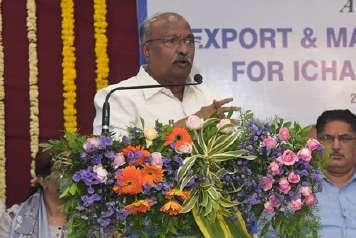
7 minute read
Sustainability Via Innovation Is Huntsman’s Major Focus

Be it digital technologies or self-reliance, Huntsman Corporation, a leader in dyestuff industry, has made rapid strides. Mr. Suhas More, Commercial Director at Huntsman Corporation speaks to the Textile Value Chain in an exclusive interview about the steps the company has taken during the present pandemic times, and also the future plans and strategies.
Advertisement
Excerpts: How did Huntsman manage during the pandemic times, esp. what were the steps to overcome the crisis?
Suhas More: One thing the pandemic has taught us is that being agile and flexible will always be critical. While the Covid-19 outbreak has proven to be a huge disruptor, it has also provided us with an opportunity to innovate and reinvent ourselves. For instance, we have leveraged technology to remain connected with our customers and developed customized products to cater to their evolving needs. As the crisis continues, it has become evident that identifying effective ways of working, collaborating, and challenging the status quo is the only way forward for the chemical industry. To become a USD300 billion industry by 2025, it is imperative that we continue building on our R&D capabilities, invest in the right talent, and leverage new opportunities as well as technologies to ensure sustained growth for the sector. The safety of our employees and partners remains our topmost priority. With the situation now returning to normalcy along with the administration of vaccines, we continue to take all the necessary precautionary measures to help curb the spread of infection.
What are the steps it took to automate/digitalise the company in the dyes & intermediates sector?
Suhas More: Applying digital technologies is becoming a strategic imperative in the chemical industry, it opens up a brighter future with ample opportunities for us. The first and the most important step is to have a proper road map. Leading companies are introducing new organizational approaches to digitalization, as they see value across their portfolios and align their organizations to best capture the advantages. Digitization is the need of the hour and is inevitable the process might be slow, but the goal will be achieved. With the GOI’s Aatma Nirbhar Bharat, and Digital India. The chemical industry saw a rapid wave of digital growth during the pandemic which has accelerated the process of digital adoption. Artificial Intelligence (AI) and big data have possibly the most potential to disrupt every aspect of a chemical company’s business model, from research and development to customer interaction, operations to compliance and shareholder value to social responsibility. However, robotics and its adoption in Indian chemical industry will be gradual given the economics and availability of skilled/semi-skilled labor compared to developed countries. Nevertheless, its value is evident in super skilled and high precision work (viz electronics, auto, 3D printing, etc.).
Key Points
• We have leveraged technology to remain connected with our customers
• The safety of our employees and partners remains our topmost priority. • The first and the most important step is to have a proper road map. • We intend to continue expanding our presence across the country in accordance with the government’s vision of making india more self-sufficient. • One of our key focus areas as a brand will be to continue driving sustainability through innovation. • India is a global dye supplier, accounting for 16% of global dyestuff and dye intermediary production.
What are the future plans & goals for the future?
Suhas More: In line with the government’s vision to make India more self-reliant, we aim to continue expanding our presence across the country, while further building on our existing product portfolio to meet the needs of diverse markets across the globe. As always, we will continue supporting our customers all over the world through the development of innovative, ecological solutions that help reduce environmental footprint and enhance resource optimization.
One of our key focus areas as a brand will be to continue driving sustainability through innovation. It is not only about developing new products, but also about ensuring that production practices are sustainable. We will continue to support our customers through the development of these solutions to help them achieve better resource optimization and cost efficiency.
We are also developing and introducing new products from time to time to cater to evolving customer needs, while also enhancing quality and enabling cost optimisation. Our innovative Novacron P range Dyes & Lyoprint printing range auxiliaries meet key requirements, combining performance and functionality with aesthetics and fashion. Together with our long-standing expertise across Digital & Traditional printing, we are well placed to support the current and future needs of the textile mills, brands & retailers.
Throw some light on the various products for the textile industry. How do they fare in eco and sustainability terms?
Suhas More: The textile industry accounts for the largest consumption of dyestuffs (about 80% of the total dye production). 40-50% of dyes produced in the developed countries find application in the paint industry, 30-40% in other industries, and less than 10% of the aggregate is used in the textile sector. However, due to the growth in export and the very high export potential of the dyestuff, the dependence of this sector on the textile sector is slowly being diluted. Further, the domestic demands for dyes are increasing due to the growth of industrial paint industries, printing industries, plastic and tannery industries, which are also consumers of dyestuff. The world market, which was traditionally highly dominated by Europe and North America, is now being slowly taken over by Asia. Asian markets are growing at a very rapid pace. Since European countries concentrate on specialty products, they have continued to remain major players in this industry. Our textile dyes, chemicals and digital inks provide the latest enhancing capabilities to finished textile of all major fibres, including cotton, polyester, wool, nylon, silk and acrylic. With respect to printing, we provide advanced digital inks to textile printers of various fabric blends which help achieve an unlimited array of complex colours and patterns while offering cost savings and resource optimisation. Our portfolio of digital inks includes our nextgeneration solutions NOVACRON ADVANCE and ERIOFAST VISTA, designed for remarkable coloristic performance at reduced energy consumption, LANASET and TERASIL inks, primarily used for apparel and sportswear, and LYOSPERSE, TERASIL and NOVACRON inks for apparel and home textiles. We also have digital ink solutions that have been developed keeping in mind the fast-growing segments of soft-signage and technical textiles. Adopting sustainable practices across the value chain, right from procurement of materials to the processing and manufacturing of textiles, has gained much needed attention in the last few years. These emerging technologies are enabling manufacturers address the triple bottom line, balancing the impact on people, planet, and profits. Sustainability matrix is a complex array of multiple variables both internal and external to the organisation.
What are the prospects of the dyes & intermediates sector? How do you think India can achieve greater performance in this sector?
Suhas More: India is a global supplier of dye, accounting for ~16% of the global production of dyestuffs and dye intermediaries. India has a strong presence in the exports market in the sub segment of dyes, pharmaceuticals, and agrochemicals. The country exports dyes to Germany, the UK, the US, Switzerland, Spain, Turkey, Singapore, and Japan. The Indian dyes and pigments market is projected to reach US$ 63.0 billion by 2022. The Indian textiles and apparel market is growing at an unprecedented rate and contributes to 7 percent of the country’s industrial output. As output grows, it is essential that the sector comes together to minimise the impact of operations on the environment. The dyeing and finishing needs of textile manufacturers in 36 countries around the globe, including USA, Germany and China are met through our manufacturing facility in Vadodara, Gujarat. Nearly 35% of the products manufactured at the site are used locally. Digital printing offers high-resolution prints with unlimited colour combinations and utilises less amount of ink, electricity, and water as compared to other traditional techniques. Huntsman Textile Effects is one of the leading providers of integrated textile solutions for every aspect of digital printing right from Preparatory and Digital Inks to finishing segments. Our Novacron XKS HD and NOVACRON ADVANCE ranges offer superior performance and enhanced reliability along with higher definition compared to similar inkjet preparations.











